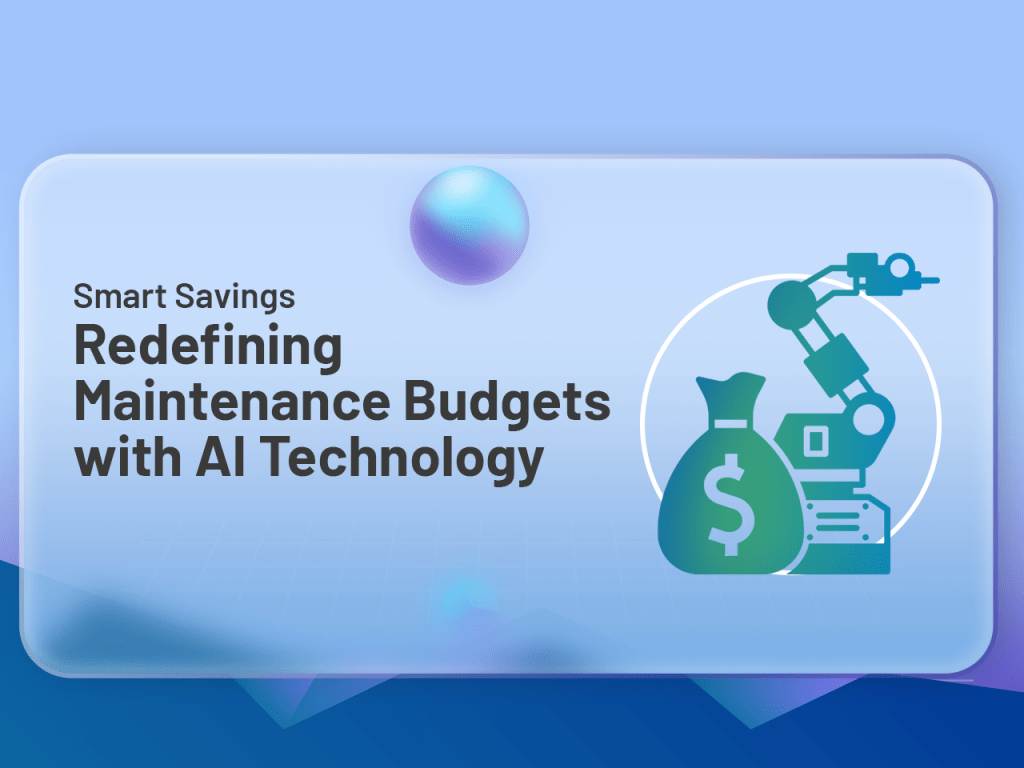Introduction
Traditional maintenance budgets often grapple with unpredictability, relying on reactive approaches that lead to increased downtime and higher costs. The lack of real-time insights and proactive strategies results in inefficient resource allocation. Additionally, preventive measures may be too generalized, leading to unnecessary expenses. These challenges highlight the need for a paradigm shift towards AI-driven maintenance, offering precision and cost-effectiveness in addressing the complexities of modern industrial operations.
In today’s dynamic business landscape, the integration of Artificial Intelligence (AI) is reshaping traditional maintenance paradigms. AI’s role goes beyond automation; it’s a transformative force in redefining maintenance cost structures. By harnessing data-driven insights and predictive analytics, AI empowers organizations to shift from reactive to proactive maintenance strategies. This blog explores how AI, as a cornerstone technology, is revolutionizing maintenance approaches, leading to smart savings and a fundamental reevaluation of budgetary considerations.
The Landscape of Maintenance Costs
The Conventional Challenges and Expenditures in Maintenance
Maintenance, an indispensable aspect of operations, grapples with longstanding challenges and expenditures. Conventional practices often face the hurdle of unplanned downtime, resulting in lost productivity and revenue. Reactive maintenance incurs high costs due to urgent repairs, while preventive approaches may lead to over-scheduled, unnecessary tasks. Resource allocation inefficiencies persist without real-time insights, and manual processes contribute to human errors. Addressing these challenges is crucial for businesses to optimize costs and enhance operational efficiency.
Importance of Efficient Budgeting for Sustainable Business Operations
Efficient budgeting is the linchpin of sustainable business operations. A well-structured budget serves as a strategic roadmap, ensuring optimal resource allocation and financial stability. It enables businesses to plan for contingencies, invest in growth initiatives, and weather economic uncertainties. Efficient budgeting fosters adaptability, allowing organizations to respond to market changes proactively. By aligning financial goals with operational needs, businesses can achieve longevity, resilience, and the capacity for innovation, laying the foundation for sustained success in a dynamic business environment.
The Power of AI in Maintenance
AI-driven Maintenance and its Capabilities
AI-driven maintenance represents a revolutionary approach to facility management and equipment upkeep. At its core, it leverages Artificial Intelligence (AI) technologies to analyze data, predict potential issues, and automate decision-making in maintenance processes. Capabilities include predictive analytics, where AI forecasts equipment failures before they occur, preventive scheduling based on real-time insights, and prescriptive maintenance, recommending optimal actions. By amalgamating data-driven intelligence and automation, AI-driven maintenance not only minimizes downtime but also maximizes the efficiency of maintenance operations, creating a proactive and cost-effective ecosystem.
How AI Technology Transforms Traditional Maintenance Processes
AI technology transforms traditional maintenance processes by introducing unprecedented efficiency and precision. Unlike conventional methods that rely on fixed schedules or respond reactively to issues, AI brings predictive analytics to the forefront. Through continuous data analysis, it anticipates potential equipment failures, allowing for proactive interventions before problems escalate. This shift from reactive to proactive maintenance minimizes downtime, reduces the need for urgent repairs, and ultimately optimizes resource utilization. Automation further streamlines tasks, enabling quicker responses and freeing up human resources for strategic decision-making. The result is a paradigm shift in maintenance processes, marked by enhanced reliability, cost-effectiveness, and operational agility.
The Potential for Cost Savings through Automation
The incorporation of automation in maintenance processes underscores a significant potential for substantial cost savings. By automating routine and repetitive tasks, businesses can achieve operational efficiency and reduce labor costs. Automated systems can continuously monitor equipment, detect issues in real time, and initiate prompt responses, minimizing downtime and preventing costly breakdowns. Additionally, streamlined workflows and optimized resource allocation through automation contribute to overall cost-effectiveness. The potential for cost savings through automation extends beyond immediate benefits, providing a long-term, sustainable solution for organizations aiming to enhance their bottom line while ensuring optimal operational performance.
Key Benefits of AI-Driven Maintenance
- Predictive Maintenance
- AI analyzes historical and real-time data for predictive insights.
- Anticipates potential equipment failures before they occur.
- Proactive Interventions
- Enables proactive scheduling of maintenance activities.
- Reduces the likelihood of unexpected downtime.
- Real-Time Monitoring
- Constantly monitors equipment for early detection of issues.
- Facilitates quick responses to potential problems.
- Preventing Emergency Repairs
- Identifies and addresses issues before they escalate.
- Avoids costly emergency repairs and associated downtime.
- Optimized Resource Allocation
- Ensures resources are allocated precisely when needed.
- Minimizes unnecessary downtime and improves overall operational efficiency.
- Long-Term Cost Savings
- Strategic use of AI-driven efficiency and proactive measures results in sustained, long-term cost-cutting benefits.
- Establishes a foundation for cost-effective and reliable maintenance practices.
Smart Savings Strategies
- Strategies for Budget Optimization with AI
- Data-Driven Decision-Making: AI leverages vast datasets to inform decision-making for budget allocation.
- Cost Prioritization: Identifies critical maintenance needs and allocates resources based on priority.
- Risk Assessment: Evaluates potential risks and allocates budget resources accordingly.
- Cost-Effective Maintenance Schedules with AI
- Predictive Analytics: AI analyzes historical and real-time data to predict optimal maintenance schedules.
- Preventive Measures: Recommends proactive interventions to address issues before they become costly problems.
- Resource Optimization: Ensures resources are utilized efficiently, minimizing unnecessary costs.
- Precision Budgeting with Real-Time Data
- Continuous Monitoring: AI enables real-time monitoring of equipment conditions.
- Immediate Adjustments: Allows for immediate budget adjustments based on changing conditions.
- Adaptive Strategies: Precision budgeting adapts to evolving operational needs, maximizing cost-effectiveness over time.
Conclusion
Quadratyx AI’s innovative approach to maintenance integrates advanced analytics and predictive insights, enabling smart savings. Precision in resource allocation, proactive interventions, and real-time adaptability characterize the cost-effective methodology. By leveraging AI technology, businesses can experience reduced downtime, avoid emergency repairs, and optimize long-term operational efficiency. Quadratyx AI invites businesses to explore these transformative solutions, fostering a proactive, cost-effective, and sustainable approach to maintenance. Embrace the future of smart savings with Quadratyx AI’s cutting-edge solutions for a resilient and optimized operational landscape.

